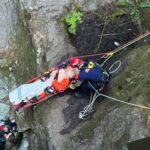
Three men died Sunday after cliff jumping into the water at a popular hiking spot in Austin, Texas, according to Austin-Travis County EMS. The incident occurred at Sculpture Falls, a swimming hole along the Barton Creek Greenbelt, highlighting the dangers associated with recreational cliff jumping even in well-known areas.
Austin-Travis County EMS reported that the incident unfolded on Sunday afternoon, prompting a swift response from emergency services. Medics were dispatched to the scene following reports of multiple individuals in distress after jumping from the cliffs into the water below. Despite the rapid arrival and intervention of rescue teams, the three men were pronounced dead at the scene. The authorities have not yet released the names of the deceased, pending notification of their families. The Austin Police Department is currently investigating the circumstances surrounding the incident.
The incident has sparked renewed concerns about the safety of cliff jumping at Sculpture Falls and similar natural swimming areas. While these spots are popular among locals and tourists alike, they often present hidden dangers, including unpredictable water depths, submerged rocks, and strong currents. These factors can quickly turn a recreational activity into a life-threatening situation. EMS officials emphasized the importance of assessing risks before engaging in such activities, stressing that water conditions can change rapidly and that even experienced swimmers can encounter unexpected challenges.
Sculpture Falls, part of the Barton Creek Greenbelt, is a well-frequented destination for outdoor enthusiasts in Austin. The area is known for its natural beauty, hiking trails, and swimming holes, attracting a diverse crowd seeking respite from the Texas heat. However, the inherent risks associated with cliff jumping are not always apparent to visitors, leading to tragic incidents such as the one that occurred on Sunday. Local authorities and park officials have repeatedly warned about the dangers of cliff jumping, urging people to exercise caution and prioritize safety when visiting these natural areas.
The incident underscores the need for increased awareness and education regarding water safety, especially in unregulated natural environments. While the allure of jumping from cliffs into refreshing water is undeniable, it is crucial to recognize the potential consequences of misjudging the risks involved. As the investigation continues, local authorities are expected to review safety measures and consider additional precautions to prevent future tragedies at Sculpture Falls and similar locations. The community mourns the loss of the three men, and their deaths serve as a stark reminder of the importance of responsible behavior and informed decision-making when engaging in outdoor recreational activities.
The investigation into the incident is ongoing, with the Austin Police Department working to determine the precise sequence of events that led to the fatalities. Preliminary reports suggest that the men may have miscalculated the depth of the water or encountered unforeseen obstacles upon entering the water. The investigation will also examine whether any other factors, such as alcohol consumption or pre-existing medical conditions, may have contributed to the tragic outcome. The findings of the investigation will be crucial in informing future safety measures and preventing similar incidents from occurring.
The Barton Creek Greenbelt, where Sculpture Falls is located, is a popular destination for hikers, bikers, and swimmers. The Greenbelt stretches for several miles along Barton Creek, offering a natural oasis within the city limits of Austin. While the area is generally considered safe for recreational activities, it is essential to recognize the inherent risks associated with natural environments. The water levels in Barton Creek can fluctuate significantly depending on rainfall, and submerged rocks and debris can pose hazards to swimmers and divers. Visitors are advised to exercise caution, stay aware of their surroundings, and adhere to any posted safety guidelines or warnings.
The deaths of the three men have prompted a wave of grief and concern within the Austin community. Local residents who frequent Sculpture Falls expressed shock and sadness at the news, highlighting the close-knit nature of the outdoor community in the area. Many have called for increased safety measures, including better signage, enhanced monitoring of water conditions, and stricter enforcement of regulations regarding cliff jumping. The incident has also sparked a broader conversation about the balance between recreational access and public safety in natural environments.
The incident at Sculpture Falls is not an isolated occurrence. Similar tragedies have occurred at other cliff jumping locations across the country, underscoring the inherent risks associated with this activity. In many cases, these incidents involve young men who underestimate the dangers involved and overestimate their own abilities. Experts warn that cliff jumping should only be attempted by experienced individuals who have thoroughly assessed the risks and are confident in their swimming skills. It is also crucial to have spotters present who can provide assistance in case of an emergency.
The Austin-Travis County EMS has issued several safety recommendations for individuals engaging in water activities, including swimming, diving, and cliff jumping. These recommendations include always swimming with a buddy, avoiding alcohol and drug consumption before entering the water, and being aware of potential hazards such as strong currents, submerged objects, and sudden changes in water depth. EMS officials also emphasize the importance of wearing appropriate safety gear, such as life jackets, especially for inexperienced swimmers or those participating in high-risk activities.
The incident at Sculpture Falls serves as a somber reminder of the importance of prioritizing safety when engaging in outdoor recreational activities. While the allure of natural environments and the thrill of adventure are undeniable, it is crucial to recognize the potential risks involved and to take appropriate precautions to minimize those risks. By exercising caution, staying informed, and adhering to safety guidelines, individuals can help prevent tragedies and ensure that these natural spaces remain enjoyable and safe for all. The community of Austin mourns the lives lost and hopes that this incident will lead to increased awareness and improved safety measures at Sculpture Falls and other similar locations. The memories of those lost will undoubtedly serve as a catalyst for change, prompting a renewed commitment to promoting responsible behavior and preventing future tragedies.
The economic impact of such tragedies can also be significant. The negative publicity associated with the incident may deter tourists from visiting Sculpture Falls and other similar attractions in the area, potentially impacting local businesses that rely on tourism revenue. Furthermore, the cost of emergency response services, investigations, and potential legal liabilities can place a strain on local resources. Therefore, investing in preventative measures and promoting responsible tourism can have both social and economic benefits.
The ecological impact of increased tourism and recreational activities at natural sites like Sculpture Falls is also a concern. Overuse can lead to erosion, pollution, and damage to sensitive ecosystems. It is important to strike a balance between providing access to these natural areas and protecting their ecological integrity. Sustainable tourism practices, such as limiting the number of visitors, promoting responsible waste disposal, and educating visitors about the importance of conservation, can help minimize the environmental impact.
The long-term psychological effects on the first responders who attended the scene should also be considered. Witnessing such a tragic event can be emotionally taxing, and it is important to provide support and counseling to these individuals. The mental health and well-being of first responders are often overlooked, but they play a crucial role in ensuring public safety and deserve adequate resources and support.
The legal ramifications of the incident are also worth considering. Depending on the circumstances, the city or county may face legal challenges from the families of the deceased. It is important to review existing regulations and policies regarding access to natural areas and to ensure that they are adequate to protect public safety. Clear signage, warning of potential hazards, and regular inspections of the site can help reduce the risk of future incidents and potential legal liabilities.
The role of social media in promoting risky behavior is another factor to consider. The desire for online attention and validation can sometimes lead individuals to engage in dangerous activities, such as cliff jumping, without fully considering the risks involved. It is important to promote responsible online behavior and to discourage the glorification of risky activities. Educational campaigns that highlight the potential consequences of such behavior can help counter the negative influence of social media.
The incident at Sculpture Falls also highlights the need for better data collection and analysis of water-related incidents. By tracking the number, type, and location of these incidents, authorities can identify patterns and trends and develop targeted prevention strategies. This data can also be used to inform policy decisions and resource allocation.
The importance of community engagement in promoting water safety should not be underestimated. Local organizations, schools, and community groups can play a vital role in raising awareness about the risks associated with water activities and in promoting safe practices. By working together, the community can create a culture of safety and responsibility.
The incident also underscores the need for ongoing training and education for emergency responders. Regular training exercises can help ensure that responders are prepared to handle a variety of water-related emergencies and that they have the skills and equipment necessary to save lives. Investing in the training and equipment of emergency responders is essential for protecting public safety.
The incident at Sculpture Falls is a complex issue with far-reaching implications. By examining the social, economic, environmental, psychological, and legal aspects of the incident, we can gain a deeper understanding of the challenges involved and develop more effective strategies for preventing future tragedies. The memories of those lost should serve as a catalyst for change, prompting a renewed commitment to promoting safety, responsibility, and sustainability in our natural environments.
FAQ:
-
What happened at Sculpture Falls in Austin, Texas?
- Three men died after cliff jumping into the water at Sculpture Falls, a popular swimming hole along the Barton Creek Greenbelt, on Sunday. According to Austin-Travis County EMS, emergency services responded to reports of individuals in distress and pronounced the men dead at the scene.
-
Where is Sculpture Falls located and why is it popular?
- Sculpture Falls is located along the Barton Creek Greenbelt in Austin, Texas. It’s a popular spot due to its natural beauty, hiking trails, and swimming holes, attracting both locals and tourists seeking outdoor recreation.
-
What are the potential dangers of cliff jumping at Sculpture Falls?
- The dangers include unpredictable water depths, submerged rocks, strong currents, and changing water conditions. Even experienced swimmers can encounter unexpected challenges that can lead to serious injury or death. EMS officials emphasize assessing risks before engaging in such activities.
-
What is the Austin Police Department investigating?
- The Austin Police Department is investigating the circumstances surrounding the incident. This includes determining the sequence of events that led to the fatalities and whether any factors, such as miscalculation of water depth, unforeseen obstacles, alcohol consumption, or pre-existing medical conditions, contributed to the tragic outcome.
-
What safety recommendations have been issued by Austin-Travis County EMS?
- Austin-Travis County EMS recommends always swimming with a buddy, avoiding alcohol and drug consumption before entering the water, being aware of potential hazards like strong currents and submerged objects, and wearing appropriate safety gear such as life jackets, especially for inexperienced swimmers or those participating in high-risk activities.
-
What measures are being considered to prevent future incidents at Sculpture Falls?
*Local authorities are expected to review safety measures, consider additional precautions like better signage and enhanced monitoring of water conditions, and potentially enforce regulations regarding cliff jumping to prevent future tragedies. Community members have also called for stricter enforcement and a balance between recreational access and public safety.
- What is the Barton Creek Greenbelt, and what kind of activities are common there?
The Barton Creek Greenbelt stretches for several miles along Barton Creek, providing a natural area within Austin. It is popular for hiking, biking, and swimming. Visitors are advised to exercise caution, be aware of their surroundings, and adhere to posted safety guidelines due to fluctuating water levels and potential hazards like submerged rocks.
- How has the Austin community reacted to the deaths at Sculpture Falls?
The Austin community has reacted with grief and concern. Local residents who frequent Sculpture Falls have expressed shock and sadness. Many have called for increased safety measures, including better signage, enhanced monitoring of water conditions, and stricter enforcement of regulations regarding cliff jumping.
- Are incidents like this common, and what warnings do experts give about cliff jumping?
Similar tragedies have occurred at other cliff jumping locations across the country, highlighting the inherent risks. Experts warn that cliff jumping should only be attempted by experienced individuals who have thoroughly assessed the risks and are confident in their swimming skills. It is also crucial to have spotters present who can provide assistance in case of an emergency.
- What is the economic impact of incidents like this on local tourism?
The negative publicity associated with such tragedies may deter tourists from visiting Sculpture Falls and other similar attractions, potentially impacting local businesses that rely on tourism revenue. Additionally, the cost of emergency response services, investigations, and potential legal liabilities can place a strain on local resources.
- What ecological impacts do increased tourism and recreational activities have on natural sites like Sculpture Falls?
Overuse can lead to erosion, pollution, and damage to sensitive ecosystems. Sustainable tourism practices, such as limiting the number of visitors, promoting responsible waste disposal, and educating visitors about conservation, can help minimize the environmental impact.
- What are the potential psychological effects on first responders who attend such tragic scenes?
Witnessing such a tragic event can be emotionally taxing, and it is important to provide support and counseling to these individuals. The mental health and well-being of first responders are often overlooked, but they play a crucial role in ensuring public safety and deserve adequate resources and support.
- What are the potential legal ramifications of the incident for the city or county?
Depending on the circumstances, the city or county may face legal challenges from the families of the deceased. It is important to review existing regulations and policies regarding access to natural areas and to ensure that they are adequate to protect public safety. Clear signage warning of potential hazards and regular inspections of the site can help reduce the risk of future incidents and potential legal liabilities.
- How does social media contribute to risky behavior like cliff jumping?
The desire for online attention and validation can sometimes lead individuals to engage in dangerous activities, such as cliff jumping, without fully considering the risks involved. It is important to promote responsible online behavior and to discourage the glorification of risky activities. Educational campaigns that highlight the potential consequences of such behavior can help counter the negative influence of social media.
- Why is data collection and analysis important for water-related incidents?
By tracking the number, type, and location of these incidents, authorities can identify patterns and trends and develop targeted prevention strategies. This data can also be used to inform policy decisions and resource allocation.
- What role does community engagement play in promoting water safety?
Local organizations, schools, and community groups can play a vital role in raising awareness about the risks associated with water activities and in promoting safe practices. By working together, the community can create a culture of safety and responsibility.
- Why is ongoing training and education important for emergency responders dealing with water-related emergencies?
Regular training exercises can help ensure that responders are prepared to handle a variety of water-related emergencies and that they have the skills and equipment necessary to save lives. Investing in the training and equipment of emergency responders is essential for protecting public safety.
- What are some sustainable tourism practices that can help minimize the environmental impact of recreational activities at places like Sculpture Falls?
Limiting the number of visitors, promoting responsible waste disposal, educating visitors about the importance of conservation, and encouraging the use of designated trails can all help minimize the environmental impact of recreational activities at natural sites.
- How can educational campaigns discourage risky behaviors like cliff jumping?
Educational campaigns can highlight the potential consequences of such behavior, provide information on safe swimming and diving practices, and promote responsible decision-making. These campaigns can be targeted at specific age groups and demographics and can utilize various media channels, including social media, television, and radio.
- What is being done to support the mental health and well-being of first responders who attended the scene at Sculpture Falls?
Support and counseling services are crucial for first responders to process the emotional impact of witnessing such a tragic event. These services may include individual therapy, group counseling, and peer support programs. It is also important to provide responders with adequate time off and opportunities for rest and relaxation.









